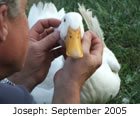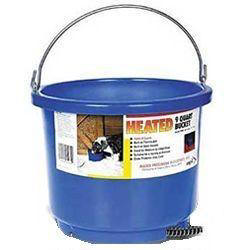| Where Are
They Now?
 We
would like
to do something very special for our December newsletter. If you
have ever adopted a duck from us, please send us a recent photo of
your new flock member along with a brief update on how the quackster
is doing. We have been in contact with many of you, but a few of you
have slipped through our fingers and we would really enjoy hearing
from you. We are planning to feature all of the ducks we have
adopted out over the course of the last year in our December holiday
issue and we want to make sure everyone is included. We
would like
to do something very special for our December newsletter. If you
have ever adopted a duck from us, please send us a recent photo of
your new flock member along with a brief update on how the quackster
is doing. We have been in contact with many of you, but a few of you
have slipped through our fingers and we would really enjoy hearing
from you. We are planning to feature all of the ducks we have
adopted out over the course of the last year in our December holiday
issue and we want to make sure everyone is included.
Please send your update
and any recent digital photos to
directorATmajesticwaterfowl.org
by November 20th. Or you can mail your update and printed photo(s)
to:

Our New Infirmary
Our
fence building may have been put on hold during all of this rain,
but that doesn’t stop us from building!
Our new infirmary
measures 8’ x 4’ and is located in the basement of our home. Inside,
ducks enjoy soft, clean bedding, food, water and a 10’ x 12’ mirror
to keep them company. Ducks requiring specialized care or quarantine
measures now have a roomy and quiet place to reside while they await
their transfer to the barn.

A Goose Named Pearl
This
letter came to us in response to our article on Hardware Disease in
our October newsletter. We wanted to share this with everyone.
Hardware Disease is a major cause of death in ducks and geese. This
letter exemplifies the risks these animals are placed in when they
are abandoned to ponds that fall in the range of hunting and
fishing. Metal objects are irresistible to ducks and geese. We
cannot stress enough the need to routinely check your yards and
enclosures for ingestible metal objects and remove them promptly.
|
Dear Kim:
My husband and I have suffered severely over the past
couple of weeks with the loss of our amazing goose
Pearl. She was a Chinese Crested goose we rescued from a
local animal shelter this past spring. She was one of
the nicest and gentlest I have ever known. We found out
that she was suffering from lead poisoning after we
noticed her seizing while trying to drink water. After
taking a blood test, we were informed by the vet that
she was suffering from lead poisoning. We proceeded with
a series of shots in the hopes of curing her. This was
all new to us, but as it turns out I hear it's all to
frequent. It's easy for birds to pick up lead fishing
weights or bird shot lying around.
I wish I knew the signs earlier; maybe we could have
saved Pearl. This is what we did notice though; she
walked as though she was tipsy, which we naively thought
was a result of perhaps being hit by a car earlier in
life since we didn't know her history. She was fine
otherwise, until just a few weeks ago when the seizures
started. We had her on the shots and helped her through
her seizures.
She was doing great after the first week of treatment
and we thought she had made it through the worst of it.
She was preening again, and sleeping standing up which
she had stopped during the time she was seizing. Then
things took such a turn, and her seizures returned worse
than ever. One day she just wouldn't come out of it. We
had to put her down and it killed us. I don't want
anyone else who loves ducks and geese like we do to go
through this. Would you mind addressing this issue with
your readers.
Thank you so much.
Sincerely,
Michelle Carey

|
Lead
Poisoning
Lead paint chips and lead shot from guns are not the only sources of
lead poisoning. Because so many domestic ducks are abandoned to
public ponds, they are in real risk of ingesting fishing gear, such
as lead sinkers and lures.
When lead is ingested, it gets into the gizzard and begins to erode.
As it erodes, lead enters the bloodstream and stores in the duck’s
body.
Have your pond and any water sources your ducks will frequent tested
for lead toxicity prior to building your pen around them or allowing
your ducks access to them. If lead levels are high, you can often
consult with the testing company or a local university about
remedying the problem.
Have the soil of your pen site tested. If lead levels are high, you
will not want to build your duck pen there. It is wise to test your
soil before building your waterfowl enclosure to avoid any issues
down the road.
A
duck suffering from lead poisoning (confirmed by a blood test) may
exhibit seizures, weakness, weight loss, drooping wings and bright green
diarrhea. It can also lead to reproductive problems and increased
susceptibility to disease or infection.
Even when lead poisoning is discovered in
very early stages, it can be difficult to remedy. Lead needs to be
removed from the system with the aid of laxatives and a round of
shots. If not discovered in the very early stages, euthanizing is
most likely the course of action your vet will recommend to avoid
any further suffering of the animal.
Surgery may need to be performed if the
discernable, lead object is inside the duck, although this tends to
be very invasive and equally risky for the duck. Most vets will
suggest euthanization as the appropriate course of action. New
endoscopic surgeries are proving effective if you can find an
experienced vet.
Edetate Calcium Disodium (Calcium EDTA or CaEDTA) is a heavy metal
chelating agent. It is injected into the animal or given as an IV
treatment. So as not to encumber you with complex chemistry, suffice
it to say that it will go into your duck’s body and bind with heavy
metals. The agent then leaves the body through the urinary tract,
taking some of the heavy metals along with it.
Side effects include diarrhea and vomiting. Since it also removes
other minerals from the body, excess loss of calcium (hypocalcemia)
can result.
Calcium levels should be closely monitored—especially in laying
hens, who rely heavily on calcium to produce their eggs. Calcium
sources should be removed during treatment and for a couple hours
afterwards, and then reintroduced again.
The Truth About Bird
Flu/Avian Influenza
Avian influenza is a naturally occurring viral infection among
birds. Many wild birds are carriers although they may never exhibit
symptoms. The virus can be passed to other birds via saliva, nasal
mucus and feces. Susceptible ducks can become infected when they
come in contact with these excretions, which are commonly picked up
at food and water sources or on pen surfaces.
Humans can catch the virus, but it is very rare that they will pass
it further along to another person.
Although it has received a lot of media coverage in the past, bird
flu is more common in dense populations of waterfowl, not often
occurring among pet ducks kept in roomy and sanitary conditions.
Unusual and involuntary movements, swimming in circles, deformation
of the neck, lack of interest in food or water, blindness, diarrhea
and nasal or eye discharge. Death usually occurs soon after the
onset of symptoms.
Your vet can perform a cloacal swab, virus isolation test for the H5
and H7 strains of avian influenza. They will need to send the sample
to a state approved, regulatory lab. It usually takes about five
days to receive test results.
The
only way to prevent outbreak is to keep your duck in a closed
environment, where no wild birds have access to their food, drinking
or swimming water and pen. Since most ducks are not kept in a
completely closed environment, you can achieve peace of mind in
knowing that outbreaks are extremely rare among healthy pet ducks
kept in sanitary conditions.
Winterizing
Winter
is coming and for those of us in colder climates, it is time to
prepare and protect our feathered friends from the cold.
Bedding is a
great source of comfort and protection from the cold ground. A thick
layer of hay should be refreshed in their shelter at least twice
daily. Do not remove old hay unless it is moldy or wet with water.
As hay is piled up on top of itself, bottom layers of hay and feces
ferment and make heat. You want to continually build a thickening
layer of hay beneath the feet of your ducks and geese over the
course of the winter (and then do a thorough spring cleaning next
year).
When the ground
is frozen, ducks and geese should have access to their dry and
bedded shelter at all times. Waterfowl can suffer frostbite if left
unsheltered and unprotected from the elements. On extremely cold
days, do them a favor and keep them locked inside of their
draft-free shelters.
Use heated
water buckets to ensure water is available to your ducks at all
times. If you do not have electricity in your barn, use Duraflex buckets.
These buckets work very well because if they do freeze over they
won't break. A water source will allow your ducks to flush out
their bills and tidy up. All water buckets should be refreshed twice daily
for best results.


Give your waterfowl a chance to bathe in a kiddie pool, basin, tub
or pond at least once a week, preferably twice a week for best
results. Even though it’s cold, they love to swim and it is
important that they do so. They need to bathe and preen to properly
insulate themselves from the cold. If your duck or goose is
shivering, give them access to water.
Do
not allow your ducks and geese unsupervised access to pools, ponds,
basins, etc that can freeze over in your absence. Waterfowl are
infamous for falling asleep in water and getting frozen in. Leaving
them exposed to freezing bodies of water can put them in serious
risk of frostbite and loss of limbs.
Insulate and draft-proof your duck and goose shelters. If your barn
or shelter is insulated, be sure the insulation is not loose or
hanging. You do not want your ducks and geese ingesting insulation.
If their shelter is not insulated, put up thick sheets of plastic on
the walls and then stack bails of hay up against the walls. Be sure
the hay is secure and can’t fall on down on top of your ducks and
geese.
Your ducks and geese do not have access to greens in summer; do them
a favor and add some healthy lettuce mixes (not iceberg) to their
daily diet. See our
April newsletter for a list of
foods to avoid. This will keep them healthy and entertained. As an
added protein source and enrichment activity, bring home a dozen
nightcrawlers for them to snack on and watch them go crazy!
Use extreme caution when using any kind of heat lamp or space
heater. Hay and shavings are EXTREMELY flammable and these devices
are the number one cause of winter barn fires. These devices should
only be used when they are professionally installed and when
instructions and maintenance requirements are specifically followed
and adhered to. Otherwise, only use these devices while you are
actually in your barn and able to supervise their function. Use them
to take the chill out of the air and then shut them off and unplug
them before you leave. If you give your ducks and geese access to
clean water for bathing, provide them thick bedding, an appropriate
level of wall insulation and an environment free of drafts, they
should not need an added heat source (unless your climate is
extremely cold, maintaining levels close to or below zero).
If
you lock your waterfowl up in a barn for the winter, be sure to take
them out at least a couple times a week for walks to keep their
lives healthy and enriched. Although they tend to prefer the indoors
when there is snow on the ground, it is still good for them to get
out into the fresh air for a bit of foraging.
|